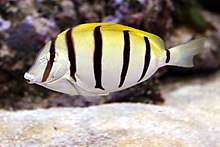Acanthurus triostegus
Acanthurus triostegus (convict tang, convict surgeonfish or manini) is a small surgeonfish in family Acanthuridae of the order Perciformes. It is typically about 10 cm (4 in) long, but some individuals may grow larger than 20 cm.[1] These tangs are widespread. They are found in the Indo-Pacific except for seas around the Arabian Peninsula, in the Pacific at the Hawaiian Islands, and in the Eastern Pacific they are found in the lower Gulf of California and down to Panama, including the Revillagigedo Islands, Clipperton Island, Cocos Islands, and Galápagos Islands with some reports throughout the Mediterranean and Adriatic Sea most likely entering through the Suez Canal.
| Acanthurus triostegus | |
|---|---|
 | |
| Scientific classification | |
| Kingdom: | Animalia |
| Phylum: | Chordata |
| Class: | Actinopterygii |
| Order: | Perciformes |
| Family: | Acanthuridae |
| Genus: | Acanthurus |
| Species: | A. triostegus |
| Binomial name | |
| Acanthurus triostegus | |
| Synonyms | |
|
Teuthis elegans Garman, 1899 | |
Description
The convict tang is so called because of its bold black stripes on a yellowish background. It is a laterally-compressed oval-shaped fish with a maximum length of about 26 cm (10 in). The head is small with a pointed snout and a terminal mouth with thick lips. It has six black stripes which distinguishes it from the zebra tang (Acanthurus polyzona) which has nine, and has a more restricted range in the Indian Ocean. The first black stripe is oblique and passes through the eye. There are two black spots on the caudal peduncle, and on each side there is a sharp, retractable spine, which is used in offence or defence.[2]
Distribution and habitat
Acanthurus triostegus occurs in the tropical Indo-Pacific region. Its range extends from the East African coast and Madagascar to southwestern Japan, Australia and Central America, including many Pacific island groups. It is found over hard bottoms in lagoons, reef slopes, bays and estuaries. Juveniles are common in tide pools, and larger fish are found at depths down to about 90 m (300 ft).[1]
References
- McIlwain, J., Choat, J.H., Abesamis, R., Clements, K.D., Myers, R., Nanola, C., Rocha, L.A., Russell, B. & Stockwell, B. (2012). Acanthurus triostegus. The IUCN Red List of Threatened Species doi:10.2305/IUCN.UK.2012.RLTS.T177965A1504553.en
- Lamare, Véronique; Mitel, Cédric (4 August 2018). "Acanthurus triostegus" (in French). DORIS. Retrieved 9 August 2020.CS1 maint: multiple names: authors list (link)
External links

- "Acanthurus triostegus". Integrated Taxonomic Information System. Retrieved 30 January 2006.
- Froese, Rainer and Pauly, Daniel, eds. (2005). "Acanthurus triostegus" in FishBase. 10 2005 version.
- Photos of Acanthurus triostegus on Sealife Collection
